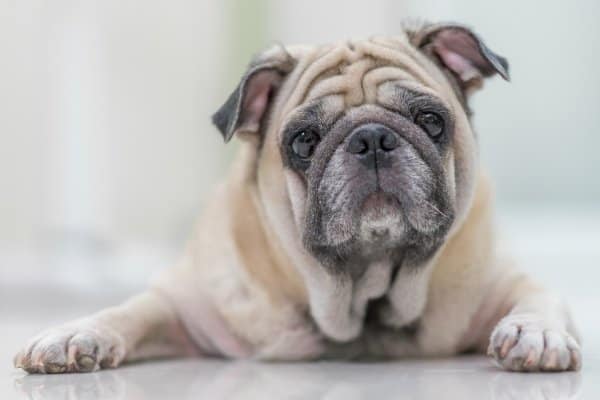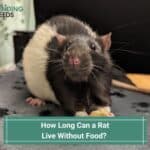We all know that the sad truth is that dogs age much more rapidly than people do. One of the reasons that we love our dogs so much is the fact that they are unselfishly willing to devote their entire lives to simply being our best friends.
While of course, it’s not pleasant to consider the total amount of time you’ll likely have with your dog, having realistic expectations for how long your Pug might live will help you to treasure each and every day and never take for granted the gift that each day with your companion is.
How long do Pugs live? Well cared for, healthy Pugs who fall within the normal weight range typically live for 13 – 15 years. Factors such as disease, neurological conditions, infection, diet, physical condition, and muzzle length can significantly shorten their lifespan.
If dogs were to live as long as we do, would we still appreciate them as much? Maybe, but maybe not. When time is limited, most people tend to place more value on each moment.
How can you be sure that you’re making the most of each day and giving your Pug the best quality of life possible? Keep reading to find out.
What Factors Influence a Pug’s lifespan?
While the average life expectancy is 13 – 15 years for a healthy, in-shape Pug, sadly, not all Pugs will make it this long. Others, however, will surpass this average and make it to their late teens.
Aside from accidents like being hit by a car or falling from a great height, there are other elements that can affect how old a Pug lives to be. Some, like genetic conditions, are predetermined while others, such as correct nutrition can be favorably controlled.
Congenital Conditions and Diseases
Like all purebred dogs, Pugs can be born with health problems or defects of the heart and circulatory system. Other diseases won’t develop until later in life.
While purchasing a puppy from a reputable breeder is your best bet at never having to worry about these issues, let’s look at the most common conditions that affect a Pug’s lifespan so that you’ll be well informed and aware.
Neurological and Spinal Conditions
Hemivertebrae refers to a condition in which the vertebrae are malformed and wedged-shaped that results in the spinal cord being compressed. This compression leads to a progressive weakening of the limbs, incontinence, and perhaps paralysis.
Constrictive myelopathy is similar to hemivertebrae but is unique to Pugs. Like hemivertebrae, this condition is a malformation of the vertebrae and leads to loss of coordination and function of the limbs and often progresses to paraplegia.
Another pug-specific disease is Pug dog encephalitis (PDE), also known as necrotizing meningoencephalitis. This devastating, fatal disease can strike Pugs as young as 2 or 3 years old and involves the inflammation of the brain and leads to seizures, marked behavioral changes, disorientation, overall weakness, and pain.
Little is known about PDE other than it is linked to a genetic defect and prognosis is grim.
Cancer
Unfortunately, cancer may strike any dog, and Pugs seem to be prone to certain forms, especially malignant skin tumors and cancers of the reproductive organs. Although sometimes treatable if detected early enough, cancer in any form is dangerous and can lead to an early death if diagnosed too late or has progressed too far to cure.
Infections
Infections are said to be the third-highest cause of death in adult Pugs, accounting for approximately 11 % of early deaths. Pugs, like all dogs, may fall prey to bacterial, viral, and fungal infections. Some are, of course, more serious than others, but the good news is that many infections can be avoided with routine veterinary care.
Diet
I’m sure you’ve heard the expression, “You are what you eat.” The same can be applied to dogs.
A low-quality diet full of fat, sugar, and empty calories can have devastating effects on a Pug’s overall health and affect his lifespan. Conversely, a nutrient-rich diet will nourish a Pug’s entire body, enabling it to remain in prime condition for as long as possible.
Pugs are particularly prone to gaining weight easily and often have a hard time shedding extra pounds once they accumulate. Obesity places a great deal of strain on the heart, spine, hips, and joints and causes breathing difficulties – something you don’t want in a breed already predisposed to this problem.
Muzzle Length
Years of selective breeding have shortened the Pug’s muzzle to the familiar smooshed look we know today. However, while the muzzle shortened over time, the internal soft tissues often still remain long and wind up being compressed, leading to a variety of issues.
Breeds with shortened muzzles (like French Bulldogs and Boxers), called brachycephalic breeds, frequently suffer from brachycephalic obstructive airway syndrome, BOAS for short. BOAS symptoms vary widely and may be relatively mild with noisy breathing and snoring, or much more serious with an intolerance to moderate exercise and heavy panting even while at rest.
Heat exhaustion, stroke, collapse, and sudden death may occur.
Exercise
Although excessive exercise can actually hurt your Pug, a total lack of exercise can be just as dangerous. Without a light workout routinely, muscles will atrophy, the heart will weaken, and overall health will fail.
Quality of Life
Pugs who suffer from diseases that are not life-threatening, such as painful eye problems or joint conditions like hip dysplasia or arthritis, or who are dealing with more serious issues like diabetes may experience a shortened lifespan.
This is especially true if their pain is not well managed or the condition is not treated appropriately.
Dogs who are in constant pain or who are simply tired of fighting so hard to remain well sometimes seem to give up the battle to stay alive. It is critical to keep a Pug with any health conditions as comfortable as possible so that he will still have a reasonably good quality of life and want to keep living.
Tips to Help Extend a Pug’s Lifespan
Of course, nature will eventually take her course, and you’ll begin to see signs that your Pug is entering his senior years. Lifelong good habits begun as soon as you bring your Pug home can work to ensure that your little friend maintains a high quality of life even as his body begins to slow down due to old age.
Maintain Weight in Ideal Range
Keeping your Pug at a healthy weight really can’t be stressed enough. An overweight Pug will eventually develop secondary health conditions as a result of the extra pounds.
To help combat obesity, feed a high-quality dog food for small breeds in correct portion sizes and offer only healthy treats occasionally.
Sure, Pugs are masters at coaxing you into submitting to their demands, but for the health and longevity of your dog, practice some tough love. He’ll eventually forgive you and be rewarded with a long, happy, healthy life.
Take Special Precautions With This Brachycephalic Breed
The Pug’s stout, heavy body, and short muzzle make swimming difficult, and hands-on supervision is a must if your Pug is allowed near a body of water. You might consider getting them a life jacket like this one.
Try to prevent your Pug from overexerting himself or becoming overly excited, as either of these could lead to breathing distress or worse. Consider a cooling vest like this – they tend to love them!
Don’t forgo exercise entirely – just keep it nice and easy, watching closely for signs of heat exhaustion and breathing trouble.
Regular Veterinary Care
Keeping current with scheduled vaccinations and having regular check-ups at your veterinarian’s office can prevent many issues from gaining a foothold. Your vet can also advise you about the best brand of dog food for your Pug and help you establish an exercise plan.
Keep Them Comfortable
Pugs just don’t enjoy air conditioning; in the warm summer months, they actually require it. They often struggle in cold weather as well because the short length of their muzzle doesn’t allow the cold outside air to be warmed before reaching their lungs.
As your Pug begins to show signs of old age, an orthopedic dog bed with elevated sides for him to rest his head on and keep his airways open may help him to sleep more comfortably.
Be sure to routinely clean the facial folds to prevent infection from occurring and to brush his teeth regularly to prevent dental decay. Brushing the loose hairs out of his coat often will not only keep your house cleaner but will also make your Pug more comfortable.





